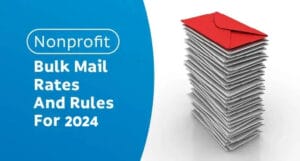Use mailing list segmentation techniques to improve the effectiveness of your direct mail campaigns
Do you want to boost your response rate and decrease your costs per lead acquisition? Smart marketers use mailing list segmentation techniques to dramatically improve the effectiveness of their direct mail campaigns.
In this article, we’ll share several mailing list segmentation ideas that pros use to create targeted mailings.
Do you know that personalized direct mail delivers 200% higher response rate, yet many mailers fail to use it? According to a DMA data report, the response rate for non-personalized mail pieces is average about 2%, while personalized pieces have response rates of 6%!
Whether you just started or you’d like just to learn more about mailing list segmentation, here are some ideas for you. What many marketers don’t know is that the tactics used to personalize email can be also applied to direct mail.
But first, let’s cover the basics.
Mailing list segmentation
Mailing list segmentation is a technique that marketers use to filter their audiences by all sorts of criteria, dividing their prospects and customers into groups or “segments”.
By understanding the characteristics of each segment, they can personalize their messages and address specific issues of their targets and thus significantly increase the response rate.
And on the top of that, a targeted campaign that uses personalization as its primary tactic saves their time and money. They target only a portion of their prospect list instead of wasting dollars sending everyone a message only some will be interested in. That’s why they measure higher KPIs.
The majority of companies participant to the Everage, Trends and Personalization Survey – 2018, conducted by Evergage and Researchscape International, reported a significant lift from their personalization efforts. You can increase by 135% the response rate just by adding a person’s name and full color to your postcards. That’s because customers and prospects expect a personalized experience, according to nearly 9 out of 10 (88%) respondents to the survey.
Audience segmentation
If you want to create a mailing list for your lead generation campaign, start with a broader list and then narrow it by adding filters, layer by layer. Testing different filters in different combinations will result in different end-consumer lists. Keep the most strong three of them for A/B testing.
First, apply the sales stage as segmentation criteria, that groups individuals into prospects, leads, new customers and return customers. Prospects are your first segment to target at the top of your sales funnel.
Further, continue segmentation with basic demographics: gender and age. It’s a well-known fact that younger individuals react better at photos and graphics, for instance, while older generations perceive more value in written texts with plenty of facts and statistics. So, the demographics will help you tailor better messages.
Men do prefer different color palettes and have different interests in terms of shopping for various products such as apparel, cosmetics, perfumes, shoes, cars, and even food habits.
The product might be not even gender-specific, but pricing, promotion, and distribution may vary widely because of distinct segments’ buying reactions of the market.
Add the location to your segmentation if you need to target individuals near your store, gym, church or dental practice. Using customer location and segmenting them based on zip code, state, region or another geographic marker is the easiest place to start creating personalized direct mailings.
All buyers should be treated with the same amount of respect, but sometimes it’s helpful to make realistic assumptions about their purchasing intentions based on their income level.
For example, for a premium car with a powerful engine, luxurious interiors, and personalized features, it would be more beneficial to group people based on income level and target only those who have a high annual income.
You can stop your targeting at this point if you offer products and services that almost anyone can use. For a saturation mailing strategy, geographic and demographic selects are plenty enough.
For a targeted mailing, continue to refine your mailing list. Now that you have your broad list, start to apply to it all your insights about your audience.
Add the life stage selects. Who are they? Parents, new homeowners, retirees or singles? Did you know that moms are the most influential shoppers in dozens of categories: clothes, beauty supplies, food, toys, shoes, appliances, etc?
AIO Model
A more refined list will include criteria related to lifestyle. Activities, Interests, and Opinion (AIO MOdel) offers a cost‐effective way to gain insights into consumers’ tendency to purchase a particular product in the near future. Here are some examples:
- Daily activities and routines: commuting, cycling vs driving a car to work.
- Interests and hobbies: crafts, cooking, spending time with family, gardening or jogging.
- Opinions, values, beliefs, likes, and dislikes. Example of a belief: “People that believe that exercising is important for their health”.
Purchase historyp can also provide valuable information about your specific audiences. For instance, you can target return customers by sharing exclusive offers, upsell and cross-sell products, that complement their last purchases.
The last criteria, lifestyle, and purchasing history reveal with higher accuracy than demographics the future consumer’s plans of purchasing certain products or services.
In conclusion, mailing list segmentation allows you to send the right message, offers, and incentives to the right person at the right time in their buying cycle. And helps you with direct mail personalization and A/B split testing to determine which direct mail piece generates a better response. Contact us today for your first targeted customer mailing list and see how our lifestyle selects and other targeting criteria fit best your insights about your ideal customers.





